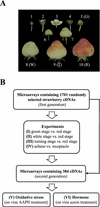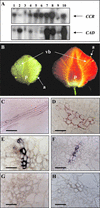Novel insight into vascular, stress, and auxin-dependent and -independent gene expression programs in strawberry, a non-climacteric fruit
- PMID: 12114557
- PMCID: PMC166497
- DOI: 10.1104/pp.003558
Novel insight into vascular, stress, and auxin-dependent and -independent gene expression programs in strawberry, a non-climacteric fruit
Abstract
Using cDNA microarrays, a comprehensive investigation of gene expression was carried out in strawberry (Fragaria x ananassa) fruit to understand the flow of events associated with its maturation and non-climacteric ripening. We detected key processes and novel genes not previously associated with fruit development and ripening, related to vascular development, oxidative stress, and auxin response. Microarray analysis during fruit development and in receptacle and seed (achene) tissues established an interesting parallelism in gene expression between the transdifferentiation of tracheary elements in Zinnia elegans and strawberry. One of the genes, CAD, common to both systems and encoding the lignin-related protein cinnamyl alcohol dehydrogenase, was immunolocalized to immature xylem cells of the vascular bundles in the strawberry receptacle. To examine the importance of oxidative stress in ripening, gene expression was compared between fruit treated on-vine with a free radical generator and non-treated fruit. Of 46 genes induced, 20 were also ripening regulated. This might suggest that active gene expression is induced to cope with oxidative stress conditions during ripening or that the strawberry ripening transcriptional program is an oxidative stress-induced process. To gain insight into the hormonal control of non-climacteric fruit ripening, an additional microarray experiment was conducted comparing gene expression in fruit treated exogenously with auxin and control fruit. Novel auxin-dependent genes and processes were identified in addition to transcriptional programs acting independent of auxin mainly related to cell wall metabolism and stress response.
Figures




References
-
- Alonso JM, Chamaro J, Granell A. Evidence for the involvement of ethylene in the expression of specific RNAs during maturation of the orange, a non-climacteric fruit. Plant Mol Biol. 1995;29:385–390. - PubMed
-
- Altschul SF, Gish W, Miller W, Myers EW, Lipman DJ. Basic local alignment search tool. J Mol Biol. 1990;215:403–410. - PubMed
-
- Avsian-Kretchmer O, Eshdat Y, Gueta-Dahan Y, Ben-Hayyim G. Regulation of stress-induced phospholipid hydroperoxide glutathione peroxidase expression in citrus. Planta. 1999;209:469–477. - PubMed
Publication types
MeSH terms
Substances
LinkOut - more resources
Full Text Sources
Other Literature Sources
Miscellaneous

